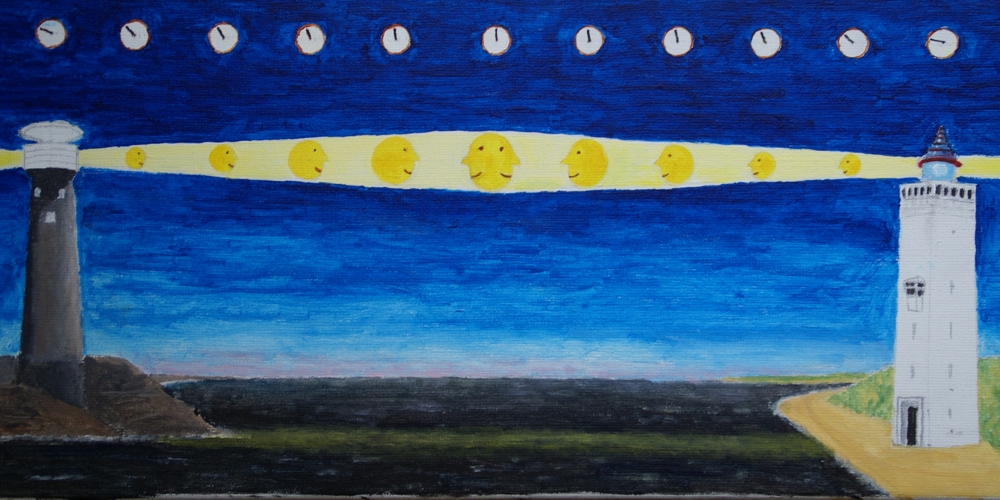Nicolaas VroomThe Speed of Light |
Back
|

|
The Speed of Light
|
Acryl on canvas 60 by 30 cm |
The above picture shows an image of my thoughts when I was roughly 18 years old in 1960.
The event shown happened at the Rijkstraatweg in Haren in the province of Groningen.
At high school (HBS) as part of the physics course I was thought that the higest speed possible was the speed of light. This subject occupied my mind.
While thinking about the speed of light I asked myself the question: Suppose I myself travel at the speed of light, what happens if a light flash approaches me from the opposite site. The speed of that light flash should be twice the speed of light and that is impossible because the highest speed is the speed of light. I never asked my physics teacher what his opinion was.
It is that specific problem that is depicted in the above picture.
At the right side you see the lighthouse of Noordwijk in the Netherlands and at the left side the lighthouse of Lands End the most western point of England. Each lighthouse emits a lightflash. The imaginary moments, how each lightflash propagates through space you can read from a clock above each flash. Starting point of each flash above the lighthouses is the same. If you look towards the lighthouse of Noordwijk (at the right) you can see, by observing the clock above the flash, that the lightflash moves towards the left. If you look towards the lighthouse of Lands End (at the left) you can see, that the lightflash moves towards the right. The two light flashes meet each other at the center at an imaginary moment at 12 o'clock
Each lightflash looks like a face. The lightflash infact imagines my face. The lighthouse from Noordwijk is the best one I remember from my youth. From my point of view the lightflash from Lands End approaches me with twice the speed of light and this supposedly should be impossible. At least that is what I thought.
After high school (HBS), at the university of Eindhoven I learned that the solution requires mathematics. You can consider your own speed mathematically, measured in your own local environment, as zero. In your own local environment the speed of the approaching lightflash is the speed of light and as such mathematically there is no problem. The mathematics that describe this solution is what are called the Lorentz Transforamtions. See Lorentz transformation
At present my point of view is different. The central issue is that this is a physical process. The same problem exist more or less when you consider a clock, specific moving clocks. If you start from two equal clocks with one staying at home (and virtual does not move) and the second one travels from A to B and back to A than you will see when the two clocks meet each other, that the moving clock runs behind and runs slower. The issue is that this slower moving of the second clock also can be described by the Lorentz transformations. The question is if this solves anything, because the the behaviour of a moving clock is mechanically a physical process.
If you again observe the painting than there is no problem: The two lightflashes crosses each other undisturbed and continue as if nothing has happened. You see no distortion and there is no collision.
In short the Lorentz transformations are not required. The same can be said in physics or astronomy
when no moving clocks are involved to measure anything.
This is also the mesage of the painting: If you make the laws of physics dependent on the speed of light than you possition yourself on a slippery road.
Nick